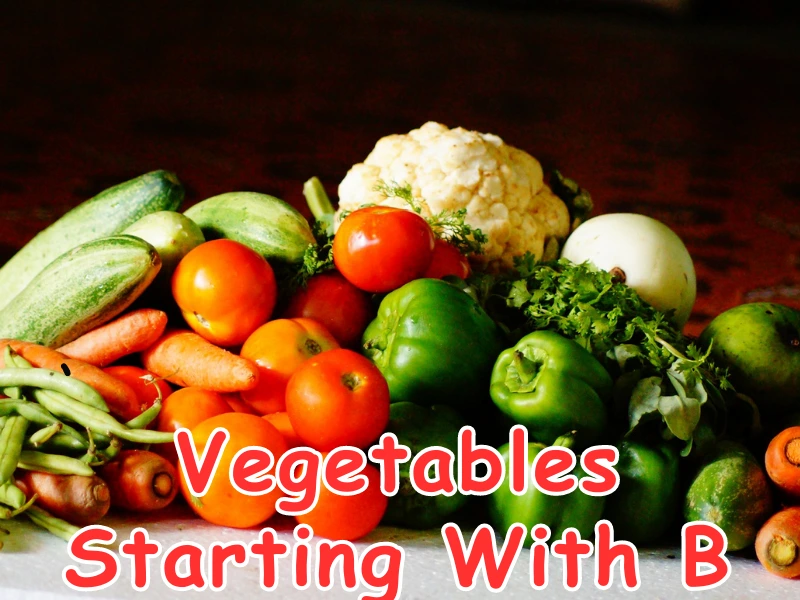
Introdction
When it comes to exploring the world of vegetables, it’s fascinating to delve into the myriad of options available. From common ones we encounter every day to more unique and exotic varieties, each vegetable brings its own flavors, textures, and nutrients to the table. In this beginner’s guide, we’ll take you on a journey through the realm of vegetables that start with the letter “B.” So, let’s get started and discover the bountiful assortment of veggies awaiting you!
Broccoli
Broccoli, a beloved member of the cruciferous vegetable family, boasts a striking appearance with its vibrant green florets. Packed with vitamins, minerals, and antioxidants, broccoli is renowned for its health benefits. Whether steamed, roasted, or added to salads, this versatile veggie offers a delightful crunch and a slightly bitter taste.
Bell Peppers
Bell peppers come in a rainbow of colors, each bringing its own unique sweetness and crunch to dishes. These colorful delights are rich in vitamin C and add both flavor and visual appeal to your meals. Use them in stir-fries, salads, or stuff them for a delightful treat.
Brussels Sprouts
Often met with mixed reactions, Brussels sprouts are miniature cabbages that offer a distinctive flavor when cooked properly. Roasting or sautéing them can bring out their natural sweetness and reduce the slightly bitter taste. They’re a great source of fiber, vitamins, and minerals.
Butternut Squash
With its sweet, nutty flavor, butternut squash is a winter vegetable that adds warmth to your meals. It’s rich in vitamins A and C, as well as fiber. Roast it, make a creamy soup, or incorporate it into casseroles for a hearty and comforting dish.
Beetroot
Beetroots, often simply referred to as beets, are known for their deep red color and earthy flavor. They’re rich in antioxidants, vitamins, and minerals. Enjoy them roasted, boiled, or pickled, and don’t forget to use the nutritious greens in salads.
Bok Choy
Bok choy is a type of Chinese cabbage that’s become increasingly popular in Western cuisine. It has a mild, slightly peppery taste and offers a delightful crunch. Add it to stir-fries, soups, or enjoy it sautéed as a side dish.
Baby Corn
Baby corn is a tiny corn variety harvested before it matures. It’s commonly used in Asian dishes and adds a unique visual element to your plate. Due to its mild flavor and tender texture, it’s a versatile addition to stir-fries and salads.
Bamboo Shoots
Bamboo shoots are tender, edible shoots of the bamboo plant. They’re often used in Asian cuisine and have a subtle, earthy flavor. These crunchy delights can be found fresh, canned, or dried and can be added to soups, stir-fries, and curries.
Bean Sprouts
Bean sprouts are young, germinated beans that provide a refreshing crunch to dishes. They’re commonly used in salads, stir-fries, and noodle dishes. Mung bean and soybean sprouts are among the most popular varieties.
Broccolini
Broccolini, also known as baby broccoli, is a hybrid vegetable that combines the flavors of broccoli and Chinese kale. It has tender stems and small florets, making it a great addition to various dishes. Steam, sauté, or grill it for a delightful side.
Broad Beans
Broad beans, also called fava beans, have a slightly earthy flavor and creamy texture. They’re rich in protein, fiber, and various nutrients. Enjoy them in soups, stews, or as a standalone side dish.
Conclusion
Exploring vegetables starting with the letter “B” opens up a world of culinary possibilities. From the familiar to the exotic, each veggie brings its own unique characteristics to your dishes. Whether you’re a seasoned chef or just starting out in the kitchen, these vegetables offer a plethora of flavors, textures, and nutrients to experiment with. So, next time you’re in the grocery store or at the farmer’s market, don’t hesitate to grab some bell peppers for a colorful salad, pick up some beets for a nutritious boost, or venture into the world of Brussels sprouts for a delightful twist on your vegetable game.
FAQs
1. Are Brussels sprouts just baby cabbages? No, Brussels sprouts are not baby cabbages. While they belong to the same family as cabbage, they are a distinct vegetable with their own unique taste and texture.
2. How can I incorporate beet greens into my meals? Beet greens are edible and nutritious. You can use them in salads, sauté them with garlic and olive oil, or add them to soups and stews.
3. Are all bell pepper colors the same in terms of taste? No, different colored bell peppers have slight variations in taste. Red peppers are the sweetest, followed by orange, yellow, and green, which is the least sweet.
4. Can I eat bamboo shoots raw? While bamboo shoots can be eaten raw, they are often cooked before consumption to enhance their flavor and digestibility.
5. Are bean sprouts and alfalfa sprouts the same thing? No, bean sprouts and alfalfa sprouts are not the same. Bean sprouts are sprouted mung beans or soybeans, while alfalfa sprouts come from the seeds of the alfalfa plant.
6. What’s the best way to store butternut squash after cutting it? After cutting, wrap the cut side of the butternut squash in plastic wrap or place it in an airtight container and store it in the refrigerator. Use it within a few days.
7. Can I freeze broccoli? Yes, you can freeze broccoli. Blanch the florets in boiling water for a couple of minutes, then transfer them to an ice bath. Once cooled, drain and freeze them in airtight bags or containers.

